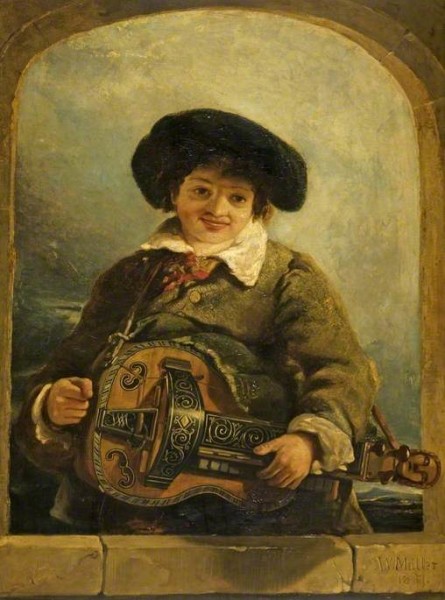
Muller, William James (1812-1845); ‘An Italian Boy with a Hurdy-Gurdy’ (1837); Cheltenham Art Gallery & Museum.
Currently tucked away in the Reserve Collections at Cheltenham Art Gallery & Museum (The Wilson) is this large painting by an early nineteenth century Bristol artist, William James Muller. Another work in the Cheltenham collection is completely different – an ‘Eastern Scene’. Muller made many trips to Egypt and surrounding areas and his work was popular in London and by patrons nationally. Other painters, notably David Roberts, were making similar trips – usually at the behest of some wealthy patron. Lord Northwick at Cheltenham and Blockley was one such patron.
Muller seemed always to retain a strong Bristol link, mainly living in the City. He was involved in the annual Art Exhibitions staged at the Bristol Institution and clearly had a strong base in the city and its art patrons. The ‘Hurdy Gurdy’ player seems rather odd – but it is probably a work done for a patron from sketches he had made when, in his younger days, he had travelled and painted in Italy. The local patrons were in the main the new breed of merchant and traders – manufacturers and dealers – building upon the historic importance of Bristol as the second city, alongside Norwich, outside London. It is interesting to note that a work with this title was in the ownership of the Acraman family- active art collectors and patrons in Bristol. The Acramans had built up a large and innovative iron and steel making business, based upon the docks and port of the city, making such things as massive anchor-chains and metal plating and machinery for Brunel’s steam ships and Great Western Railway – including iron bridges and station seating. Unfortunately the Acraman businesses suffered disastrously from the vagaries of the market, financial, and new and experimental engineering – complicated by the fact that several major local banks went bankrupt upon which the Acramans had relied for a steady cash flow on innovative projects. The result was that the Acraman empire went bankrupt – necessitating the sale of their personal large and important art collection by Christies in 1842, in the city. Amongst the lots for sale was a painting with this title, the buyer not yet identified. The Cheltenham work emerged into the open when it was given to the gallery in 1959. It is not certain that this is the same painting as in the Acraman collection – but the only other one I have come across is a rather sketchy work and not up to the standard of the Cheltenham work, Acraman was a discerning collector who required the best from the artists he patronised.
The ‘Hurdy Gurdy Player’ was typical of the collecting taste of many early nineteenth century patrons – who had made their wealth in new technologies and products and fully supported British art and modern British artists. As they expanded they moved out of cramped inner-city houses, in Bristol also being their warehouses, to new developments in the purer air and more spacious surroundings outside, but close by, the city – examples being the Clifton area of Bristol and the Lansdown area of Cheltenham. New houses needed to be newly furnished – in the contemporary taste and fashion – and paintings were an essential part of the furnishings to be seen and discussed at personal social gatherings. The ‘Hurdy-Gurdy Player doubtless was a regular talking point.
David Addison. October 2018.
